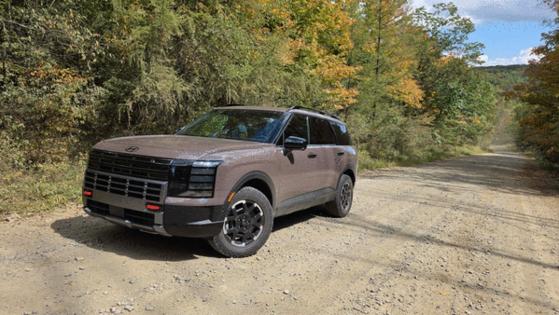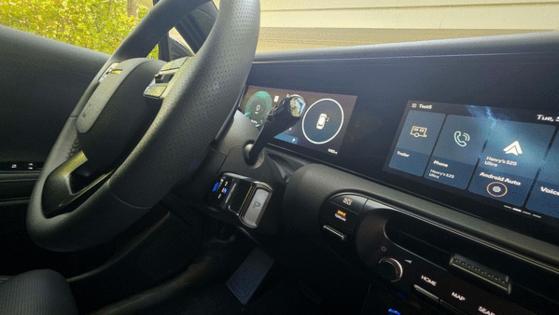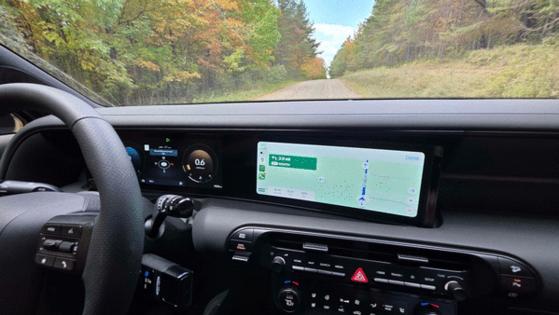Auto review: (Off and on) road trippin' in the Hyundai Palisade XRT Pro
Published in Automotive News
WATKINS GLEN, New York — The 2026 Hyundai Palisade has an off-road-focused XRT Pro model because, well, you never know when Google Maps will navigate you off-road.
Heading east from Niagara Falls toward Watkins Glen International Raceway, Google sent me off Interstate 86 and onto a series of two-lane state roads — including dirt roads.
Had I been driving a sports car, I would have cursed Google (how dare you dirty my sleek stallion!). But my Palisade XRT Pro was in its element.
I punched the TERRAIN button on the dash, then selected SAND mode (MUD and SNOW are also on offer) and the Hyundai engaged all four Hankook all-terrain tires. I charged up the steep New York hills, leaving a rooster tail of dust behind me.
“Look at the fall colors!” I exclaimed as the V-6 engine roared past trees painted orange, red and yellow.
“Look out for farm trucks coming over these brows!” said my long-suffering wife riding shotgun.
Family road trips can be fun. Americans love three-row haulers and off-road bruisers, and Hyundai has combined the two flavors — like Reese’s peanut butter and jelly — to create a tasty recipe. With the Palisade XRT Pro, Hyundai follows in the footsteps of other models like the Ford Explorer (Timberline model), Chevy Traverse (Z71) and Honda Passport (TrailSport) — to marry its family hauler with the latest in off-road tech. It’s awesome.
Sitting atop my XRT Pro tester in Metro Detroit afternoon traffic, I marveled at how ga-ga we’ve gone for the adventure craze. In front of me was a Jeep Wrangler Rubicon. To the left of me a Toyota 4Runner TRD, and to the right of me a Traverse ZR1. All armed to the teeth with all-terrain tires, jacked chassis, plastic fenders and off-road modes to ... pick up the kiddies from school.
My weekend trip to the Glen (where I would be racing in an SCCA regional race), however, would show off the Palisade’s full arsenal in its natural habitat: an 18-hour road trip through international borders, interstates, service stations — and yes, even dirt roads.
The Palisade was separated at birth from the Hyundai Group’s other three-row ute, the Kia Telluride. They share the same bones, interior amenities, and even off-road capacities (the Telluride’s XRT Pro doppelganger is called the X-Pro). But let’s face it, the Telluride has overshadowed Palisade with its upscale, Cadillac-like styling: vertical lights cues, tidy grille, scalloped flanks. Kia has even applied these attributes to the K4 sedan to make one of the most upscale mainstream compacts in the market.
The Palisade, meanwhile, went its own way with a typically funky sci-fi Hyundai design. Sometimes it works (ooooh, that Elantra is pretty) and other times, ahem Palisade, it looks a bit butch.
The XRT Pro model, however, allows Palisade to lean into macho design.
Check out the cool stacked headlights and chunky wheels married to a wardrobe of Cast Iron Brown paint, black body cladding, one-inch suspension raise and a front grille that looked like it came off, well, my barbecue grill. Butch becomes XRT Pro.
Hyundai derives the Palisade name from the steep “palisade” cliffs of California and the Hudson River — bold, natural features that inform the SUV’s bold, upright design style. My journey didn’t go as far as the Hudson, but it did take me across the natural wonders of Lake Erie, Niagara Falls and the Empire State’s Finger Lakes region. And with 418 miles of driving range, it could make the trip to Watkins Glen without a gas stop, unlike its $20K-more expensive, 320-mile-range electric sibling, the Hyundai Ioniq 9, which would require a 30-minute charging stop.
For such long-distance duty, the Palisade is outfitted with an interior as funky — yet functional — as its exterior.
The design is a pleasant combination of rounded door handles amid a chunky horizontal console, dash and door pockets. The slavish adherence to horizontal design form restricts storage space in the doors as, say, a vertical door cut-out for a tall water bottle would fit the XRT Pro’s adventurous passengers.
But, as a whole, the cockpit has upscale character, particularly the steering wheel, which sports a unique blocky design and excellent ergonomics for adjusting cruise control speed and radio volume without taking your eyes off the road.
The dash is dominated by Hyundai’s familiar twin instrument and infotainment screens and complemented by clever ergonomics. Palisade moves drivetrain operations — including the START button — to a single stalk on the steering wheel, which opens cargo space in the center console. Sub-storage for my wife’s purse, cupholders, phone charger, the works.
Family reaction to this was mixed. My son Sam drove Palisade around the Glen and found the stalk annoying because he couldn’t see it behind the chunky wheel spokes. Be sure to bring your USB-C phone charging cables! Multiple ports are littered through the cabin — but none are USB.
On interstates like I-90, the Hyundai was smooth as silk, though I missed the hands-free Super Cruise and BlueCruise systems offered by, respectively, Chevy Traverse and Ford Explorer. The Hyundai’s adaptive cruise required a constant hand but it did prove smart at using GPS to navigate the road. For example, it slowed for I-90’s famed 35-mph, 90-degree turn through Cleveland. Smart car.
After Mrs. Payne and I grabbed Burger King to go, she took over cruise duties while I played third-row passenger.
Second-row captain’s chairs collapse forward with the touch of a button next to the headrest for access to the third row. My 6’5” giraffe legs were tight but there was room for my phone (another USB-C port), onion rings and drink.
Better still, I could flatten the seatback in front of me (using a lever on the second row seat’s base) to make an ottoman. With my legs stretched out, I checked email while sipping my beverage. So quiet was the cabin that when we made a call, I could join the conversation as if we were on speaker phone in our living room.
As the road hours dragged by, the Hyundai offered pleasant, voice-activated diversions.
Me: Hey, Hyundai, tell me a joke.
Palisade: How do robots eat guacamole? With computer chips.
Me: Hey, Hyundai, set the cabin temperature to 70 degrees.
Mrs. Payne: Hey, Hyundai, set the passenger temperature to 72 degrees.
A feature called SOUNDS OF NATURE is also available in the screen to soothe with, for example, forest sounds of tweeting birds and rustling leaves. Or I could just wait for Google to divert me onto a dirt road and experience the forest for myself.
2026 Hyundai Palisade
Vehicle type: Front-engine, front and all-wheel-drive, three-row SUV
Price: $41,035, including $1,495 destination fee ($51,110 XRT Pro as tested)
Powerplant: 3.5-liter V-6; Hybrid 2.5-liter inline 4-cylinder mated to electric motor and 1.7 kWh battery
Power: 287 horsepower, 260 pound-feet of torque (V-6); 329 horsepower, 339 pound-feet of torque (Hybrid)
Transmission: 8-speed automatic (V-6); 6-speed automatic (Hybrid)
Performance: 0-60 mph, 6.6 seconds (Car and Driver); towing, 5,000 pounds (V-6), 4,000 pounds (Hybrid)
Weight: 4,420-4,872 pounds
Fuel economy: EPA, 19 mpg city/24 highway/20 combined (V-6 FWD); 16 mpg city/22 highway/19 combined (AWD XRT Pro); Hybrid TBD
Report card
Highs: Rugged presence; upscale cabin
Lows: Snug third row; some USB ports, please
Overall: 4 stars
____
©2025 www.detroitnews.com. Visit at detroitnews.com. Distributed by Tribune Content Agency, LLC.

















Comments